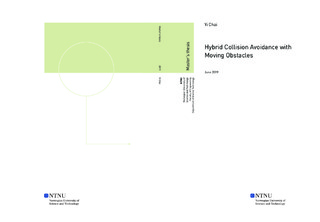| dc.description.abstract | A considerable amount of work has been done in the field of Autonomous Surface Vehicles (ASV) over the past few decades. Autonomous path planning and collision avoidance (COLAV) are essential for ASV navigating in unknown or partially known environment with both static and moving obstacles in the vicinity of the vehicle. This thesis proposes a hybrid COLAV approach based on the integration of a global path planning algorithm and a reactive collision avoidance approach to address the COLAV issue with the presence of the moving obstacles.
B´ezier curves are exploited as the basis for global path planning, which is formulated within the framework of optimization, involving constraints like continuity, boundary conditions, static obstacles, etc. Property of differential flatness is used to assign a cost to each path that reflects the dynamic capabilities of the vehicle, yielding the optimal path by minimizing the objective function. In addition, a combined pure pursuit and line-of-sight (PLOS) steering law is implemented to follow the global path.
As a reactive collision avoidance technique, dynamic window (DW) algorithm is employed to search for optimal velocity pairs which ensure collision-free trajectory handling both static and dynamic obstacles. Extensive modification has been done to adapt original DW algorithm to the hybrid COLAV method by incorporating a path alignment function into the objective function. In particular, the interface between the deliberative and reactive method is developed, enabling the vehicle to simultaneously track the generated global path towards the given goal and avoid local collision.
The performance of this hybrid COLAV method has been evaluated through numerical simulations, and the hybrid COLAV method performs very well handling both static and moving obstacles. Besides, robustness to noisy measurement has also been tested by considering Gaussian noise with different standard deviations. Moreover, the major downside of the reactive DW algorithm, high sensitivity to local minima, is addressed with the guidance of the global path. However, for future work, it should be further investigated to perform maneuvers compliant with the International Regulations for Preventing Collisions At Sea (COLREG). | |
